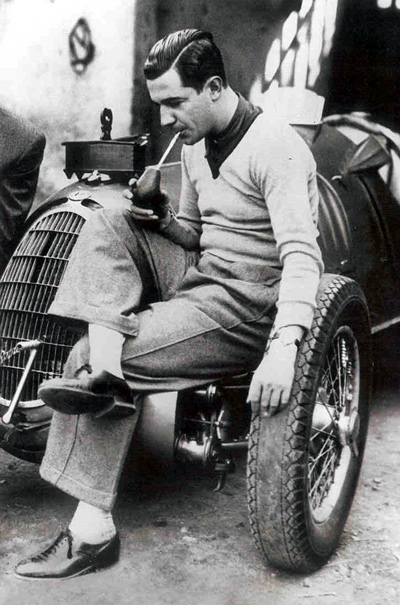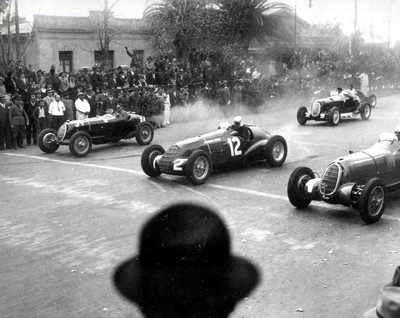June 7th, 2006
Alfa Romeo Argentina, Part I
By Cristi�n Bertschi and
Estanislao Iacona
$175.00 dollars, including registered airmail shipping worldwide.
Hardbound, 12 x 9 3/4 inches, 355 pages, B&W photography
Payment methods: transfer to US account, all main credit cards through paypal.
Send Orders to: lao@whitefly.cc
Review by Pete Vack

An example of the excellent photography in "Alfa Romeo Argentina"; an 8C Alfa Romeo at Retiro, Buenos Aires, in 1941.
|
How little we know about Argentina, how fascinating is the terrain. Yet Argentina is perhaps the last frontier of lost Italian treasures.
"Alfa Romeo Argentina" opens up a new chapter in Alfa Romeo history and research, one fraught with mysteries, enigmas and misconceptions. Although time itself is making research increasingly difficult, perhaps only the team of Estanislao Iacona and Cristi�n Bertschi are qualified and capable enough to chronicle the history of Alfa Romeo in Argentina.
Both authors have contributed to VeloceToday. Estanislao Iacona (b.1970) is a lawyer and Cristi�n Bertschi (b. 1974) is an architect and history teacher. Both live in Buenos Aires and share a passion for Italian cars, Alfas and Ferraris in particular. After ten years of research, Iacona and Bertschi reviewed the material they discovered, and fabricated a work which would fit the needs of the subject.

Buenos Aires is at located at the mouth of the River Plate, the Pampas to the west and Patagonia to the south. One third of the total population of Argentina lives in this great capital city.
|
Argentina is a unique country, and this is a unique book. It is one of the few automotive books we've ever encountered which devotes the first fourteen pages to the social, economic and political history of a country. Written by Teresa Gonz�les Bonorino de Iacona, the mother of Estanislao Iacona, it gives the reader a background of Argentina from 1900 to 1972...roughly the period of time covered by the book in terms of racing Alfa Romeos. This introduction is followed by chapters devoted to the most important Alfas brought into the country, peppered with chapters on Argentine race drivers such as Ricardo Nasi and Juan Manuel Fangio, while another chapter discusses the "Argentine Alfa" of the 1950s. It is for the most part new material and most welcome, regardless of organization. The text is in both English and Spanish. The English translation is, at times, a bit rough, but should prove no problem for us English readers, who should be eternally grateful for the translation.
The history lesson is essential, because to understand Alfa Romeo in Argentina, one must understand at least a little about Argentina itself. Be forewarned, however; even Argentine novelist Marcos Acquinas claimed that "To understand the Argentines is a hopeless task". In the early 1900s, Argentina was a country whose horizons were unlimited, and whose vast natural wealth had hardly been tapped. Between 1895 and 1912, over six million Europeans immigrated to Argentina, more than doubling the population. They came to work on the cattle ranches, in the cities, and to take part in the rapidly growing industries. The majority of these immigrants were from Italy and Spain, and they provided a colorful, sometimes volatile cultural mix. From our Italian-oriented point of view, the large population of Italians and Sicilians had a significant impact on the history of the automobile and automobile racing in Argentina.

Villa Car� Costa in the mid-1920s. The architecture of Buenos Aires reflected European cities such as Madrid and Rome, providing the thousands of Spanish and Italian immigrants a feeling of home away from home.
|
It is difficult to imagine Argentina without Buenos Aires, for more than one third of the total population of Argentina lives in or around Buenos Aires. It is not only the capital, but the gateway to the rest of the country. On the outskirts of the city lies the Pampas to the west, the semi-tropical provinces to the north and Patagonia to the south. Once a Creole and Spanish stronghold, by the 1900s Buenos Aires suddenly became a melting pot, but very European in character. Buenos Aires (yes, it means "Good Air", but the name was taken from the patron saint of the sailors--"The Virgin of the Buenos Ayres") became a replica of the cities of Europe, primarily Rome, Madrid and Paris. The intensely European flavor of Argentina still exists today.
Where the Italians went, cars were soon to follow. Alfieri and Ettore Maserati had arrived to assist Isotta Fraschini around 1908, and Fiat established a network in Buenos Aires by 1919. In 1923, Eduardo Car�, of Italian ancestry, wanted to buy an Alfa Romeo, but there was no dealer in Argentina. He and his son, Eduardo Jr., would solve the problem by starting one themselves.

The Car�s, Eduardo Jr. at left, his father at right, in their new Alfa Romeo showroom. Shown is a 3 liter 6 cylinder RL, probably bodied in Argentina.
|
Thus began the era of Alfa Romeo in Argentina, with a showroom at the intersection of Santa Fe Avenue and Talcahuano, in the high, expensive north side of Buenos Aires, where the rich had moved in the 1870s to avoid the yellow fever. The Car�'s "villa" was on the Rivadavia, the grand main street which leads to the National Congress building and the Plaza de Mayo, where so much Argentine history was dramatically played out.
Car� Jr. decided to import a Targa RL, and raced it on several occasions, but the Car�'s attempt to establish a beachhead for Alfa did not succeed. Another Italian, Alberto Roccatagliati, took their place and imported 6C 1500s, 6C 1750s and other Alfas from 1925 to 1930. This might have gone unnoticed, but Roccatagliati also invited Italian Vittorio de Rosa to drive a newly imported P2 Grand Prix car, the first and only appearance of the car outside of Italy. This made news.
The authors, finding a gold mine of photos which resided with relatives, bring this era into focus, tracing the race history of not only the Targa RL, but the P2. The fate of the lesser Alfas remains a mystery, but it is remarkable that so many documents of these early dealers and racecars survived--and that the authors have found them! The photos are simply incredible and in superb condition.
By 1930, Argentina was the world's eighth largest economy. It was riding high, the star of South America. The sexual and intense Tango became the musical language of Argentina, made famous by a French born crooner, Carlos Gardel. But it was also the beginning of the world wide depression, and difficult times for Argentina. Roccatagliati closed his Alfa Romeo dealership. The millions who came to work in a growing, prosperous Argentine were now becoming known as the "shirtless ones".

Evocative photo, but taken in 1951, as the first Alfa Monza, serial number 2311209 arrives in Buenos Aires. The new owner, Adolfo Schwelm Cruz, is at left with gloves. A second, but unidentified Monza was also imported, the fate of which remains a mystery.
|
Argentina's depression was virtually over by 1937, and the thrill of racing grew, and new race tracks were built and more races were held in the streets or parks of Rosario, La Plata, and Buenos Aires. Alfas continued to be imported, raced by a growing number of home grown, excellent race drivers such as Oscar Galvez, Ricardo Nasi, Carlos Arzani and Juan Fangio.

Carlos Arzani sips a "mate", a green tea, while resting on his 8C, serial number 50014. Later, after being significantly modified, 50014 was further destroyed in a fatal accident in 1948.
|
The cover of "Alfa Romeo Argentina" is dominated by a photo, which at first glance might appear to be a poor choice for this critical location, given the richness of the photographs inside. Once having read the book, the reason becomes apparent. On the grid of a race at La Plata, Argentina, on May 7th, 1939, are four distinct Alfa Romeos, each representing a model imported into the country during the 1930s: A Tipo B (P3), an 8C Grand Prix car, an 8C 2900A, and one of the three 308 GP Alfas which found their way into Argentina. In any country, it is an imposing lineup. The reader can look forward to finding out about the fates of each of these cars and their mates, as the authors, with the help of Simon Moore, ("The Immortal 2.9" and "The Legendary 2.3s"), have written tales and stories

Le Grande Alfa Romeo, Argentina style. La Plata, 1939. At left, a Tipo B, serial number 50009 (SF49); in the center, the Tipo 308, number 50017, with Ricardo Nasi at the wheel; at right, Carlos Arzani in the 8C35 (or 8C1935), and seen in the second row, an 8C2900 A.
|
of destruction, modification beyond recognition, lost in warehouses for decades, and just plain missing in action. For example, the degeneration of an 8C 2900 Spider Corsa, "...the Alfa Romeo that participated in more races than any other in Argentina..." also was the one that "...suffered the greatest number of modifications throughout time." Imported by Carlos Arzani in 1936, by 1951 the car had very few Alfa Romeo parts left anywhere on the machine. Ironically, despite its fame, the chassis number has never been determined! Mysteries and riddles abound, and leave one eager for more answers.
There is, of course, some speculation about certain chassis numbers and events, and may not be the final word. This is to be expected. While the final word may never come, at least we have this much to ponder.
Following the years of recession, the country faced an uncertain future as the influence of the Axis Powers-- Spain's Franco, Italy's Mussolini and of course the German military---held sway with the politicians and generals of Argentina. The post war era in Argentina would be very different from what had come before, but the new leaders would have a positive effect on Argentina's success in the international racing arena.
Next week:1946-1972



